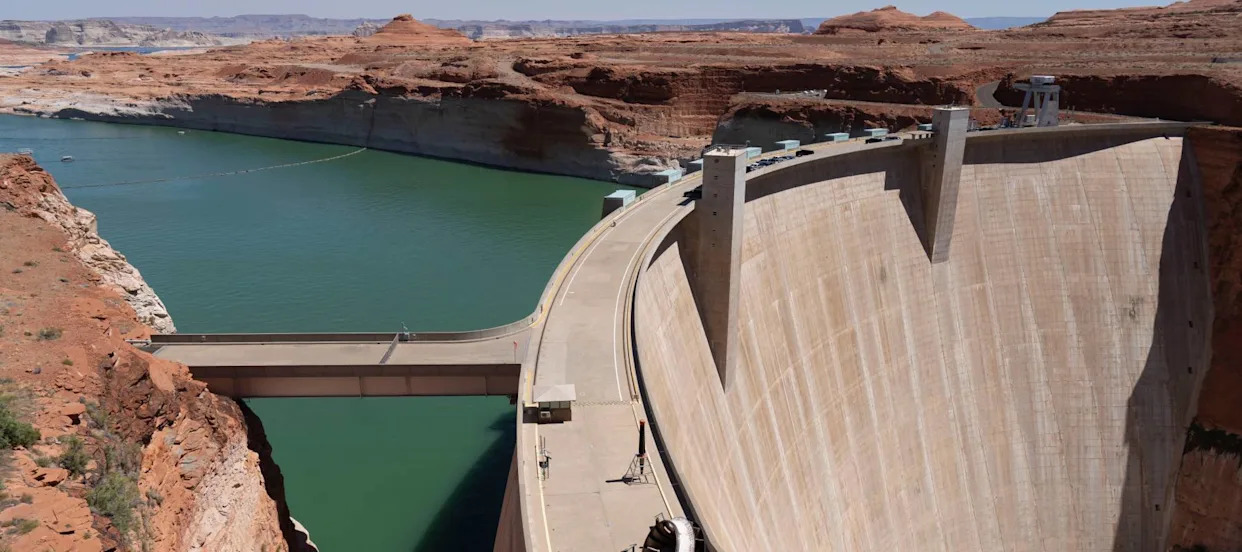
The U.S. Bureau of Reclamation has issued a harrowing warning on the dangerously low water levels in Lake Powell, which could drop below critical levels as early as 2026.
Water levels at the man-made reservoir in the southwest may approach the "minimum power pool" elevation of 3,500 feet by December of next year, potentially halting hydroelectric production at the Glen Canyon Dam, according to AZ Family. Minimum power pool represents the lowest elevation at which water can still pass through the turbines of a dam.
Don't miss
Thanks to Jeff Bezos, you can now become a landlord for as little as $100 — and no, you don't have to deal with tenants or fix freezers. Here's how
I'm 49 years old and have nothing saved for retirement — what should I do? Don't panic. Here are 6 of the easiest ways you can catch up (and fast)
Robert Kiyosaki warns of a 'Greater Depression' coming to the US — with millions of Americans going poor. But he says these 2 'easy-money' assets will bring in ‘great wealth’. How to get in now
If this were to happen, residents in seven west coast states — Wyoming, Utah, Colorado, New Mexico, Arizona, Nevada, and California — could experience potential blackouts and water shortages. But it gets worse — as of now, Lake Powell’s water levels sit 184 feet above what’s called the “dead pool,” the level at which a dam can no longer release water downstream.
Years of drought left Lake Powell dangerously low
Located along the Utah-Arizona border, Lake Powell serves as the primary storage for the Colorado River system, supplying water to roughly 40 million people across seven U.S. states. But the last 25 years have been intensely dry, with lake levels dropping to just 30% by August 2025.
Glen Canyon Dam’s storage was at 7,706,910 acre-feet as of July 15, 2025, according to the Bureau of Reclamation — the lowest value observed on that date in the last 30 years. The 2025 water year for the Colorado River Basin is currently the sixth driest on record since 1964.
Lake Powell’s current elevation — 3,554 feet above sea level — is just 64 feet above the dam’s penstocks, which are used to generate hydroelectric power. Just 120 feet below the penstocks are three bypass pipes designed to help the flow of water from the Colorado River, but the efficacy of those pipes has never been tested over an extended period. Below the bypass pipes is the dead pool, which occurs at around 3,370 feet above sea level.
“If the lake level were to fall below the level of the penstocks, you start to have engineering concerns with the dam itself, but also you have water delivery concerns,” Zak Podmore, author of the book Life After Dead Pool, told AZ Family.
The Bureau of Reclamation’s 24-month study shows that Lake Powell could soon fall below two critical elevations:
3,525 feet by April 2026 or as soon as January, which could trigger emergency drought response actions
3,490 feet by December 2026, which would halt power generation
And while these numbers are concerning, some experts believe all hope is not lost.
“Lake Powell is currently at about 30% of full capacity. That’s obviously quite low, but it’s been significantly lower than this in 2021, and we didn’t hit dead pool at that time,” Mark Squillace, water policy researcher and professor of natural resources law at the University of Colorado Law School, shared with KUNM.
“It’s not likely that we’re going to see dead pool at Lake Powell.”
Stay in the know. Join 200,000+ readers and get the best of Moneywise sent straight to your inbox every week for free. Subscribe now.
What reduced hydroelectric output means for locals
In the 1990s, high water levels saw many southwestern desert communities thrive on Colorado River water and Glen Canyon Dam hydropower, but maintaining those water levels has been a challenge in the 21st century.
When Lake Powell is full, the dam can generate up to 1,320 megawatts of electricity, which equals roughly five billion kilowatt-hours of power annually. With Lake Powell currently at 30% of full capacity, the Glen Canyon Dam’s hydropower production has been cut down significantly in recent years.
If the dam were to stop generating electricity, a study by the Glen Canyon Institute found that residents in the impacted areas could expect increased energy prices of around $3.53 per month when adjusted for inflation, or about $42 annually. However, that total likely understates the long-term burden on residents and overlooks the potential closure of other drought-hit dams.
While there’s little residents of the southwest can do to spur on enhanced snowmelt or rainfall, there are some basic steps residents can take to help offset their reliance on energy from the Glen Canyon Dam:
Research alternatives, like natural gas, to potentially reduce reliance on hydroelectric power
Install solar panels with battery storage on your property
Increase energy efficiency to reduce overall consumption
Support renewable energy policies
What to read next
Want an extra $1,300,000 when you retire? Dave Ramsey says this 7-step plan ‘works every single time’ to kill debt, get rich in America — and that ‘anyone’ can do it
Here are 5 simple ways to grow rich with real estate if you don’t want to play landlord. And you can even start with as little as $10
Rich, young Americans are ditching the stormy stock market — here are the alternative assets they're banking on instead
Here are 5 ‘must have’ items that Americans (almost) always overpay for — and very quickly regret. How many are hurting you?
This article provides information only and should not be construed as advice. It is provided without warranty of any kind.








Comments